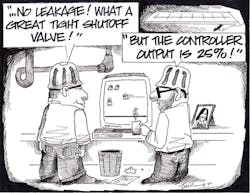By Greg McMillan and Stan Weiner, PE
Greg: What are the two applications you worked on with biggest benefits?
Sheldon: I was responsible for the development of the Type 546 I/P transducer that for many years was the industry standard for I/Ps. Many of the I/P products on the market at the time were sensitive to vibration. In the development of the 546, I made a special effort to address this issue in the product design. It is rather gratifying that from the introduction of the 546, it has been relatively trouble-free in the field. Even today, there are millions of these units in service.
|
CLICK HERE |
|
As a research engineer for Fisher Controls, I developed the first positioner application guidelines. These guidelines were developed as a result of control-loop stability problems leading to positioners on bypass and not used when needed. Also, I developed Fisher Controls’ guidelines for two-stage pressure reduction to reduce the incidence of instability due to loop interaction.
Sheldon Lloyd holds an ME and worked at Fisher Controls and Monsanto. He co-founded Fieldbus Inc. and was its president for 10 years. He holds five patents, is a former senior member of ISA, a licensed engineer and a past member of the Visiting Committee for the Department of Electronics and Computer Engineering, University of Texas. Now retired, he rides elephants and does other fun stuff.
A lot has changed since that time in the design and speed of response positioners can achieve. The new digital positioners in particular represent a major advancement in positioner technology. The introduction of digital process controllers has had a significant impact on the application of digital positioners. In general, the older analog controllers have a much wider bandwidth in their frequency response than their digital equivalents. In many distributed control systems, the PID may be configured for a slow period of execution. Consequently, the rules in applying valve positioners have dramatically changed. The original guidelines advocated application of positioners on selected applications; whereas, the appropriate guideline today is to always use a positioner unless very special conditions exist. This universal use rule is especially true when the positioner settling time is faster than the control module execution time.
Stan: Thus when upgrading a control system that has been in place for many years, it is always good to review what valves do not have positioners and add positioners as part of the project. Often the improvement in performance is significant and can make a big difference in reducing process variability.
Greg: A positioner also can make a big difference when tuning a control loop by reducing the stick-slip and dead- band as seen by the controller.
Stan: What were your greatest technical achievements?
Sheldon: To help better communicate the importance of process control understanding, Gerald Anderson and I wrote the book, Industrial Process Control. This text was used in the control classes offered by Fisher Controls for many years.
I retired from Fisher Controls just about the time Fisher, Rosemount, Yokogawa and Siemens were starting on what would eventually evolve into the Fieldbus Foundation Specification. One of the greatest hurdles was the fact that many of the traditional instrumentation manufacturers were not strong in software development. Thus, soon after the release of the first draft of the Fieldbus Foundation specification, I cofounded Fieldbus Inc. The goal was to make it easier for instrument and valve manufacturers to make the transition to fieldbus technology. I feel this initiative was one of the keys to the wide success that fieldbus has achieved.
Greg: What are the two greatest opportunities in process control today?
Sheldon: There is a significant challenge ahead for our industry in training new engineers in basic process control. With the big reduction in technical resources within many plants, there is less support around to help a new engineer learn the things he or she needs to know. This challenge offers new opportunities to find better ways to transfer process knowledge within engineering organizations. The increasing computing power available in field devices also offers a significant opportunity for manufacturers to provide features that prevent abnormal situations and improve control use.
Greg: Not all positioners and control valves are created equal. My worst experiences have been with on-off valves (isolation valves) sold as throttle valves after a one-stage, low-gain positioner has been added to a cylinder actuator. They do a good job of being either open or closed, providing tight shutoff and dealing with high temperatures and hazardous fluids. However, lost motion and sticktion set the scene for the extreme sport of deadband (backlash) and resolution (stick-slip) for the positioner. Add to this a low-performance positioner, and you are going to have a sustained oscillation large enough to get on your performance review. These limit cycles persist, regardless of tuning in any PI/PID loop with valve stiction, and in any level or cascade PI/PID loop with valve deadband. Just to make things more insidious, positioners on rotary valves that measure actuator shaft position rather than ball or disk stem position for feedback may indicate everything is fine from the positioner’s perspective. (See my Control articles “Has Your Control Valve Responded Lately?”, June 2003; “Life is a Batch,” June 2005; and “A Fine Time to Break Away from Old Control Valve Problems” , Nov. 2005, for more details.)
|
CLICK HERE |
|
Process engineers doubling as instrument engineers (see my blog, “Missing in Action,” are the prime market target for these valves.
Since some readers look forward or backward as the case may be to a Top Ten List, here is my latest offering.
Top Ten Signs Your Control Valve is an On-Off Valve in Disguise
(10) Valve body looks suspiciously like the block valve next to it.
(9) Actuator looks suspiciously like the one on the interlock valve.
(8) Process engineer is seen going to lunch with the valve supplier.
(7) The valve deal is a steal.
(6) Your flow is on-off.
(5) Positioner measures actuator shaft instead of ball or disk stem position for feedback.
(4) Limit-cycle amplitude exceeds largest data historian compression setting.
(3) 360° feedback in your loop becomes 360° feedback in your performance review.
(2) The valve package is nicknamed “Sloppy Joe.”
(1) No leakage till the controller output is 40%.
This Month’s Puzzler: Boosters for Valve Positioners?
What happens when you put a booster on the output of a valve positioner? Send an e-mail with your answer to the Puzzler, CONTROL questions, or comments to [email protected].| About the Authors |
Greg McMillan and Stan Weiner, PE bring their wits and more than 66 years of process control experience to bear on your questions, comments and problems. Write to them at [email protected].








